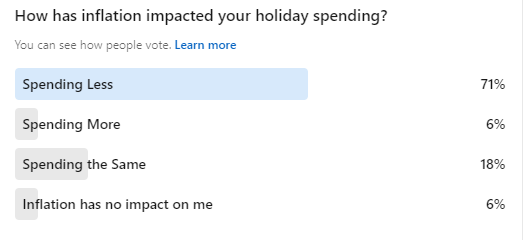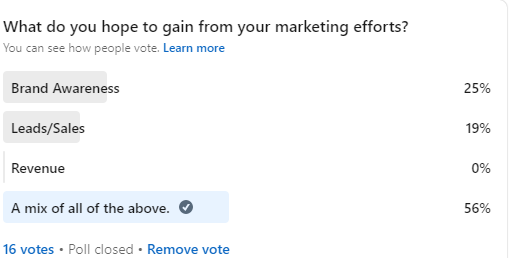Survey of 2023 Holiday Spending
I surveyed my audience on LinkedIn on how their spending was impacted by inflation.
This is an updated extension of my last report where I surveyed my audience on LinkedIn about their holiday spending intent, method of purchase, types of purchase, and sentiment in the U.S. Consumer spending is always top of mind for marketers, sellers, and retailers.
This year, I focused only on inflation and holiday spending.
- How has inflation impacted your holiday spending?
How did inflation impact your spending during the holiday season? Share your thoughts.

As you can see, 71% percent said they spent less during this holiday season. Consumers must see value in what they are buying. Brands need to create memorable experiences for consumers with their offerings
Based on my research, my finding suggests:
- Inflation has dampened consumer spending during the holiday season.
- Customers are taking a closer look at their finances this year.
- Brands need to provide value offerings that create memorable experiences for customers.
How did inflation impact your holiday spending?
Please share your thoughts and join the conversation.
Additional places to find my content and blog
WordPress: https://dangalante.me/
Tumblr: http://www.askdangalante.com/
LinkedIn: https://www.linkedin.com/today/author/DanGalante
Medium https://medium.com/@DanGalante
YouTube https://www.youtube.com/trendsettingsm
Anchor https://anchor.fm/dangalante
About Me
I’m a Strategic Marketer with Field Sales, Sales Enablement, Content Creation, and, Classroom Teacher/Trainer skill sets using Marketing to drive Sales/Growth.
As a Marketer, I’ve worked with Start-Ups, a Political Campaign, and a Digital Marketing Conference.
I’m certified in Inbound Marketing with classes in Marketing, Product Management, Product Marketing, SEO, and SEM.
Before teaching, I was an Outside Sales and Marketing Rep. selling and marketing dental products to Dentists using consultative selling, trade show marketing, field marketing, and market research.
I publish Sales, Marketing & Social Media Today a blog covering industry events and trends.
I’m seeking a full-time role in
Inbound Marketing, Digital Marketing, Content Marketing, Product Marketing, CI, Demand Generation, Social Media Marketing,
Sales Enablement, Enablement, Sales Strategy, Marketing Strategy, Employer Branding, and Recruitment Marketing.
Open on title, industry, company, location, and level. Reach out on LinkedIn or at dan@dangalante.com to start a conversation.






